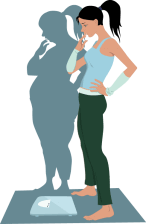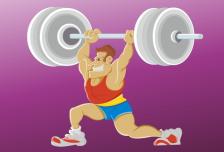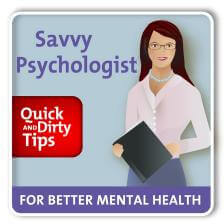Do You Have a Body Image Disorder?
The Savvy Psychologist, Dr. Ellen Hendriksen, joins Get-Fit Guy to explain Body Dysmorphic Disorder (BDD) and how it can wreak havoc on your life. The good news is that Dr. Hendriksen has 6 tips on how to overcome your body image issues and feel great about yourself.
When I was 12-years-old, my dad brought home a set of 10-pound dumbbells from the local sporting goods store. I had no clue how to use them, but I remember grabbing them from his room one day, taking them into my bedroom, lying face-down on the edge of the bed, and attempting a teenage boy’s version of biceps curls until I couldn’t lift those weights anymore.
Sponsor: This episode is brought to you by DailyBurn, the best fitness anywhere. Access online workout videos featuring a variety of programs, from tabata to interval training to yoga. Get the first 30 days free when you go to dailyburn.com/getfitguy.
I had absolutely no clue what I was doing. But one thing I did know for certain: the next day my arms were very, very sore. And – perhaps a little bigger? Just like many boys, I flexed my muscles in the mirror, and it certainly did seem like my arms grew a bit. Not only did that mean these dumbbells might make me stronger or faster, but they might make me look better too – and at that time in my life, that meant two things: girls looking at me and guys being jealous of me.
Through high school I continued to lift weights and actually got what I (and others) would describe as a nice “bod.”opens IMAGE file And yes, I kept on flexing in the mirror to check out my muscles every now and again to make sure nothing seemed out of place. Abs toned? Check. Arms not looking too small? Check. Calves getting out of toothpick mode? Check.
In college, while studying exercise science (no surprises there, right?) I learned about body fat testing, and added that tracking parameter into the mix – every week hopping on a scale to make sure I never saw any double digits (which somewhere in the back of my mind meant I could be risking not looking good in my swim trunks or increasingly tight t-shirts). I also began to fret endlessly over food – not in an anorexic, caloric-restriction kind of way – but more in a fat-phobic, extreme calorie counter, have complete control over every bit of food that goes in my mouth kind of way.

In fact, back then if you had taken one shred of muscle fiber off my body, or told me I couldn’t lift weights or exercise anymore, I would have immediately experienced a slight lowering of confidence, a hint of depression, and lots of plain ol’ grumpiness.
Of course, as a bodybuilder, I was constantly surrounded by hundreds of men and women just like me. Men and women who cared – cared a lot – about their bodies and how they looked. So was this bad? Is this unhealthy? In today’s episode, I have as my guest the newest Quick and Dirty Tips host, the Savvy Psychologist Dr. Ellen Hendriksen to fill us in on body image issues and give us some tips to feel great about our bodies no matter what.
Ellen, take it away…!
Thanks, Ben, I’m delighted to be on your show!

Of course, preoccupation with body image isn’t limited to bodybuilders. Many people believe that if only their bodies were different, perfect, or more like a Victoria’s Secret model’s or Hugh Jackman’s, they’d be happy. What you courageously reveal, Ben, is that even when you’ve achieved “the ultimate body,” the pride and public recognition still didn’t banish that hint of depression, that grumpiness, or that chip in your confidence. You backed away from the unhealthy side of the bodybuilding world and are happier—and, notably, healthier— for it.
Body Dysmorphic Disorder Explained
At its most extreme, obsession with appearance has a label: body dysmorphic disorder, or BDD. Celebrities from Bruce Jenner to Hayden Panettiere, and of course, Michael Jackson, have been rumored to suffer from it.
BDD is an obsession with a perceived flaw—a supposed defect that appears minor or even non-existent to most observers. It could be an obsession that one’s Adam’s apple is too big, feeling tortured over some minor acne scars, or an absolute certainly that one’s perfectly-normal-looking-to-others nose will draw ridicule and humiliation if anyone sees it. The distress about the flaw is so strong that some sufferers only go out at night, cover the perceived flaw with clothing or oddly combed hairstyles, check a mirror hundreds of times a day, or undergo multiple surgeries (many of which are elective and paid out of pocket – again, Michael Jackson is the perfect example). Sadly, surgery or dermatologic treatment doesn’t cure the problem. That’s why individuals with BDD often run from doctor to doctor, or throw their money away on sham miracle cures.
Bigorexia

The Broken Mirror by Dr. Katharine Phillips is the BDD treatment bible, and many people with BDD—who make up 1-2% of the U.S. population—report feeling more understood and hopeful after reading it. Another book called The Adonis Complex by the same author addresses muscle dysmorphia and men and boys’ quest for physical perfection to the detriment of everything else.
BDD is often treated with a class of antidepressants called SSRIs and cognitive-behavioral therapy, a structured type of therapy that challenges the beliefs underlying BDD, like “I can’t go out because my abs aren’t chiseled enough,” plus the behaviors that go along with those beliefs.
Ben, you also mentioned fretting endlessly over food in your previous life. While you’re certainly within healthy limits now, it sounds like back then you, as well as many others in the bodybuilding world, may have come close to a proposed new eating disorder: orthorexia.
Orthorexia

Orthorexics eat what they perceive to be a healthy diet and obsessively avoid foods they think are unhealthy, like fat, animal products, or additives. Ironically, their diet can end up so restrictive that it actually leads to malnutrition. Inevitably, orthorexics experience hunger and cravings, but instead of expanding their diets, they feel guilty and ashamed, and react by becoming even more strict, thus creating a vicious circle.
Again, it’s not an official diagnosis yet, so there aren’t hard and fast diagnostic criteria, but here are some things to consider: Is your diet isolating? Many people with orthorexia lose friends or fight with a partner because they look down on others’ ways of eating. They have a hard time being around people who don’t eat as “healthily” as they do and thus eat only alone at home. Also, how much time does it take up? Thinking about healthy eating more than 3 hours a day could signal a problem. Control is also a big factor: orthorexics may feel in total control when they follow their diet, but guilty and self-hating when they slip, even by one bite. And finally, as the diet of an individual with orthorexia gets “healthier,” his or her life actually gets worse.
Now, it’s totally fine to follow a comparatively strict diet, like veganism, Paleo, or a raw food diet, as long as it enhances your life and you choose to do it, rather than restricting your life and feeling like you’re compelled to do it. Remember that most disorders are extreme versions of normal behavior. Healthy eating, like most behavior, lies on a spectrum; the extreme end—where it causes distress and impairment—is where we start to worry.
6 Tips to Feel Great About Your Body
To feel great, here are 6 tips to help you be kinder to your hardworking body. After all, where would you be without it?
-
Tip #1: Think about not only what your body looks like, but what it can do. I know of a teacher who’s quite a bit overweight, but she’s a karate instructor and a sixth-degree black belt. I guarantee she’s not thinking about her body shape in the middle of a flying kick. Do the same and find an activity that makes you feel powerful, peaceful, or plain ol’ good in your body, whether it’s the weightlessness of swimming, the rhythm of Zumba, or the camaraderie of a walking group.
-
Tip #2: “Fat” and “soft” are not feelings. Many women use “I feel fat,” and men use “I feel soft,” as shorthand for “I feel bad.” Don’t conflate fat or softness with negative feelings. If you feel demoralized, ashamed, vulnerable, or self-conscious, call it what it is. It’s easier to deal with a feeling directly, rather than through the filters of “fat” and “soft.”
Many women use “I feel fat,” and men use “I feel soft,” as shorthand for “I feel bad.” Don’t conflate fat or softness with negative feelings.
-
Tip #3: Argue back to your thoughts. Think of your thoughts as little monsters that keep whispering rude, insensitive things to you: “Your stomach is gross!” “You shouldn’t have eaten that, you cow.” “You’re disgusting.” Would you say these things to someone else? Would you say such damaging things to a child? Of course not. Then why the double standard? Stand up for yourself like you’re worth standing up for, because you are.
-
Tip #4: Stop comparing yourself to others. Shame is a terrible motivator. Limit your exposure to situations that make you feel bad about your body until your body image gets stronger (notice I said your body image—you don’t have to change your body at all, just your perception of it). Walk out of snooty studios or gyms where you feel judged or no one talks to you. Stop buying fashion or fitness magazines that make you feel inadequate. And for heaven’s sake, stay away from those “best” and “worst” beach bodies features at the checkout stand! You’ll breathe a sigh of relief.
-
Tip #5: Likewise, stop commenting on others’ appearance or eating. It perpetuates a culture of judgment where everyone loses. Say something positive. For example, if you see a large person struggling to jog, just say “Good for her.”
-
Tip #6: For inspiration, read Anne Lamott’s “The Aunties,” a hilarious essay on accepting jiggly thighs, or Wendy Shanker’s The Fat Girl’s Guide to Life, which is self-explanatory (and also hilarious). For men and women, Mark Sisson’s The Primal Connection explores, among other topics, meaningful exercise—thoughtful alternatives to exercising just to look good or get a training high.
Body image issues lie at the core of eating disorders and BDD. It’s not easy to push back against a culture where Kelly Ripa’s arms make headlines. But look around you. Look at everyone, not just the Jolie-Pitts. Chances are, when you broaden your view to see all shapes and sizes of real people, you and your body fit right in.

If you have questions about body image issues, or want to talk more about body dysmorphic disorder or feeling great about your body, then join the discussion over at Facebook.com/GetFitGuy. And if you know someone who has or is headed for BDD, make sure to email them a link to the Savvy Psychologist podcast so that they could stop that train before it gets into dangerous territory.
References
Donini, L., Marsili, D., Graziani, M., Ibriale, M., & Cannella, C. (2005). Orthorexia nervosa: Validation of a diagnostic questionnaire. Eating and Weight Disorders, 10, 28-32.
Phillips, K. (1996). The Broken Mirror: Understanding and Treating Body Dysmorphic Disorder. Oxford: Oxford University Press.
Pope, H.G., Phillips, K., & Olivardia, R. (2000). The Adonis Complex: How to Identify, Treat, and Prevent Body Obsession in Men and Boys. New York: Touchstone.
Body image disorder and other images courtesy of Shutterstock.







